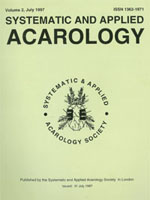Typhlodromus bambusae Ehara is a dominant predator species associated with the spider mite Schizotetrany-chus nanjingensis Ma & Yuan on the giant bamboo (Phyllostachys pubscens) in Fujian, China. In the field, increaseddensities of T. bambusae were associated with reduced densities of S. nanjingensis on bamboo leaves. Laboratory studies at 22–30°C on a diet of S. nanjingensis showed that females of T. bambusae completed a full egg-egg cycle in 7.5 days and mated females laid an average of 3.2 eggs per female per day. The number of female prey consumed by predator females increased with prey density very fast initially at prey densities of ≤5 but levelled off as prey density was further increased. Prey handling time was over 40% shorter and the rate of successful attack was twice higher at 28–30°C than at 22–24°C. When fed the pollen of Luffa cylindrica or eggs and larvae of Tyrophagus putrescentiae, T. bambusae females could not survive to layeggs.However,predator females readily attacked females of T. kanzawai and were able to reproduce normally on this diet. T. bambusae could complete development on T. kanzawaias fast as on S. nanjingensis. The potential of T. bambusae as a biocontrol agent in integrated control of S. nanjingensis is discussed.
How to translate text using browser tools
1 July 1999
Biology of Typhlodromus bambusae (Acari: Phytoseiidae), a predator of Schizotetranychus nanjingensis (Acari: Tetranychidae) injurious to bamboo in Fujian, China
Yanxuan Zhang,
Zhi-Qiang Zhang,
Qiaoyun Liu,
Jianzhen Lin
ACCESS THE FULL ARTICLE

Systematic and Applied Acarology
Vol. 4 • No. 1
July 1999
Vol. 4 • No. 1
July 1999
life history
predation
Schizotetranychus nanjingensis
Typhlodromus bambusae




